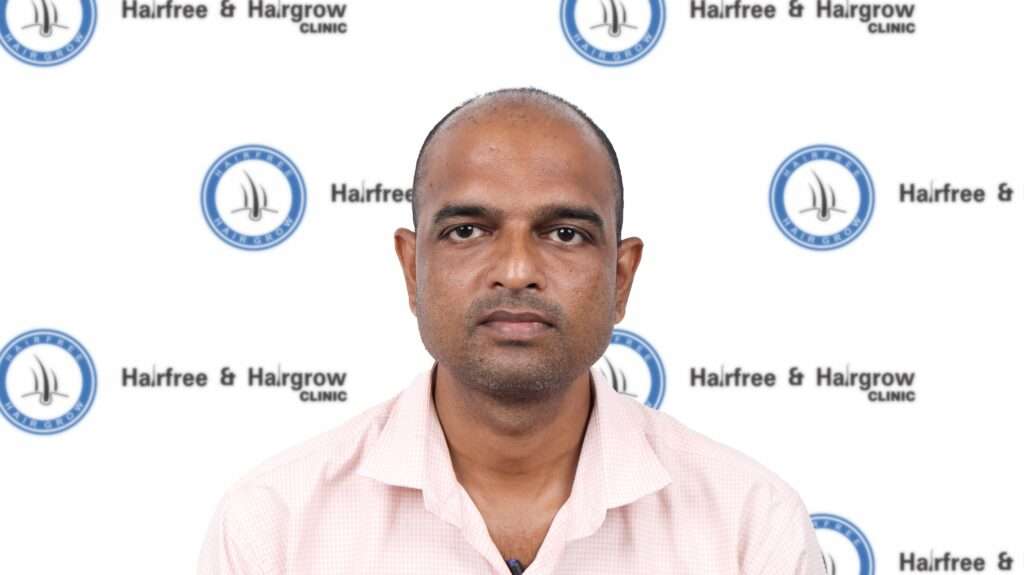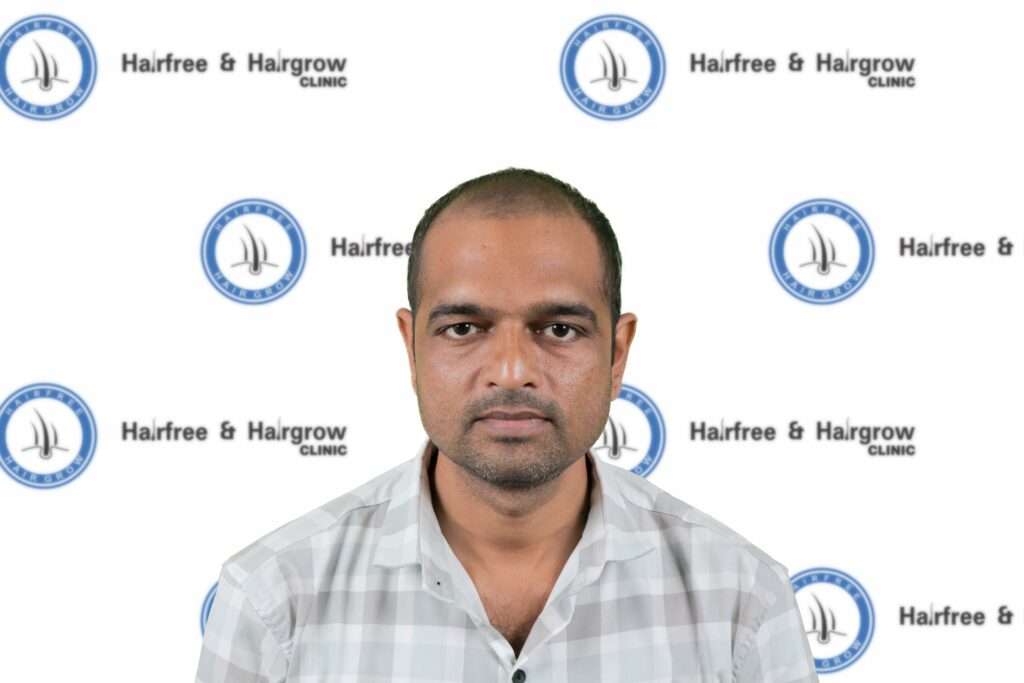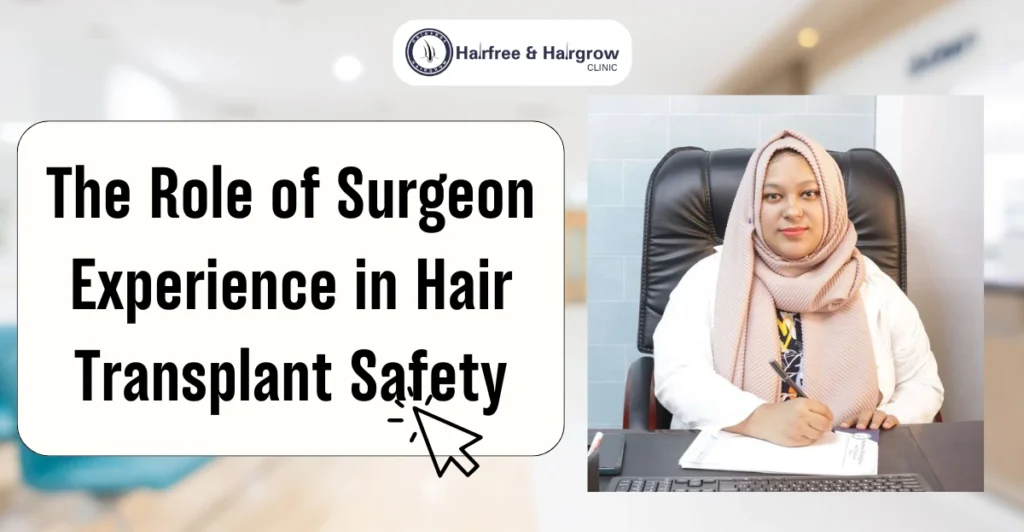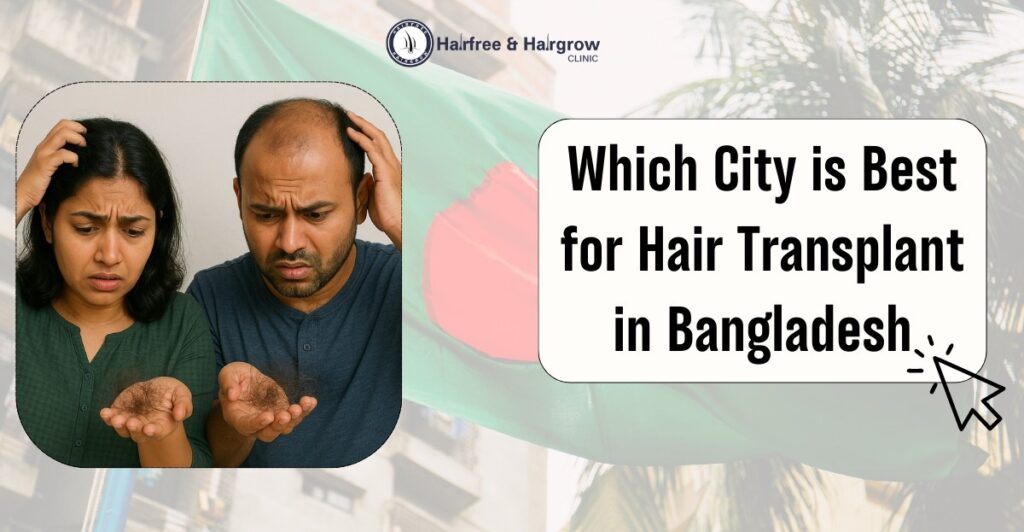Hair transplant timeline – Navigating the journey of hair restoration requires understanding the stages of recovery and growth following a hair transplant. This blog provides a clear overview of what to expect at each key milestone. Hair Transplant timeline 10 days, 20 days, 1 month, 3 months, 6 months, 9 months, and 1 year—so you can stay informed and manage your expectations effectively.
At Hair Free Hair Grow Bangladesh, we offer advanced hair transplant solutions designed to solve your hair loss problems. With years of expertise and numerous successful cases, our top hair transplant surgeons deliver natural, long-lasting results, making us a trusted destination for the best hair transplants in Bangladesh.
Whether you are dealing with the early stages of hair loss or considering the full hair loss process, we are committed to helping you regain your confidence and find the most effective solution to your hair loss problems.
Table of Contents

Hair Transplant After 10 Days

Ten days post-hair transplant is a crucial milestone in your recovery journey. Here’s what you can expect, along with answers to some common questions about this stage:
- Scabs and Crusts
By day 10, scabs and crusts around the transplanted area should mostly be gone. It’s important to gently remove any remaining scabs to avoid inhibiting hair growth and damaging the new hair follicles. You can touch your hair at this point, but be very gentle. Use a mild shampoo, like tea tree shampoo, to help with this process. Your surgeon might also suggest specific products to reduce itchiness, making this phase more comfortable. - Hair Grafts
At this stage, your hair grafts should be securely settled and have restored their blood flow. While they are now more stable, it’s still vital to treat them with care. You can touch your hair lightly, but avoid rubbing or scratching the grafts to ensure they stay firmly in place. - Swelling and Discomfort
Swelling and discomfort typically subside by this point. However, you may still feel some tenderness around the grafts. This is completely normal and part of the healing process. You may be wondering if it’s safe to return to work after 10 days. Generally, it is possible to go back to work, especially if your job isn’t physically demanding. However, it’s important to avoid any activities that might strain your scalp or disrupt the healing process. - Hair Loss
Don’t be alarmed if you notice some hair shedding. This phenomenon, often referred to as “shock loss,” is a normal stage in the post-transplant journey. During this time, the newly transplanted follicles temporarily pause their activity, leading to the shedding of existing hair shafts. It’s a crucial part of the process before new, healthy hair begins to emerge. - Hair Growth
Although you might be eager to see new hair sprouting, it’s important to note that visible hair growth is unlikely at this stage. Full hair growth can take several months, so patience is key. Regarding physical activities, it’s best to avoid working out 10 days after your hair transplant. Exercise can increase blood flow to the scalp, which might interfere with the healing process. Wait until your surgeon gives you the green light before resuming your fitness routine.
Tips for Care:
- Gentle Washing: Continue to wash your hair with a mild shampoo to keep the scalp clean and promote healing.
- Avoid Scratching: Be mindful not to scratch your scalp, even if it feels itchy.
- Return to Work: If your job isn’t physically demanding, you can consider going back to work after 10 days.
- Postpone Workouts: Hold off on exercising until your doctor confirms it’s safe to resume.
- Follow Your Surgeon’s Advice: Adhere to any additional instructions or product recommendations provided by your surgeon to optimize your results.
Medication & Maintenance:
At this early stage, your surgeon might prescribe antibiotics to prevent infection, and anti-inflammatory medications to reduce swelling. Additionally, some patients are recommended to start taking hair growth supplements or medications like Minoxidil (Rogaine) or Finasteride (Propecia) to support hair growth and prevent further hair loss.
Hair Transplant After 20 Days

Twenty days post-hair transplant marks a pivotal moment in your healing process. As you move further along this journey, here’s what you can expect, along with insights into the changes happening beneath the surface:
- Shedding and Shock Loss
Around the 20-day mark, you may notice an increase in hair shedding. This phase, known as “shock loss,” is completely normal and expected. The transplanted hairs enter a resting phase and shed before new hair growth begins. While it may feel concerning, this shedding is a sign that your follicles are preparing for new, healthy hair growth. - Scalp Condition
By this stage, your scalp should feel much more comfortable, with most scabs and crusts gone. Any residual tenderness should be minimal. It’s crucial to continue treating your scalp with care. Use a gentle shampoo to keep the area clean, but avoid any harsh scrubbing or scratching, as the newly transplanted follicles are still delicate. - Graft Stability
The hair grafts should now be firmly anchored in the scalp. While they’re more secure, it’s still important to handle the area gently. You can touch your hair, but make sure to do so with clean hands and a soft touch to avoid disturbing the healing process. - Swelling and Discomfort
By day 20, any swelling and discomfort should have completely subsided. If you experience any lingering discomfort, it’s usually mild and manageable. This is also a good time to assess how your scalp is healing and consult with your surgeon if you have any concerns. - Hair Growth and Expectations
At this point, visible hair growth is still unlikely, and your scalp may look similar to how it did before the transplant. However, beneath the surface, your hair follicles are gearing up for the growth phase that will become more apparent in the coming months.
Tips for Care:
- Gentle Hair Care: Continue using a mild shampoo to maintain a clean and healthy scalp. Avoid aggressive washing or rubbing.
- Managing Shedding: Understand that shedding is normal and part of the process. It’s a positive sign that your scalp is preparing for new growth.
- Activity Level: If you haven’t already, you can likely return to light work and daily activities. However, still refrain from strenuous exercise or activities that increase blood flow to the scalp.
- Follow Up: Consider scheduling a follow-up appointment with your surgeon to discuss your progress and any concerns you may have.
Medication & Maintenance:
At the 20-day mark, your surgeon may continue to recommend the use of Minoxidil or Finasteride to enhance hair growth and prevent further hair loss. If you’re experiencing significant shedding, PRP (Platelet-Rich Plasma) therapy could be introduced. PRP involves drawing a small amount of your blood, processing it to concentrate the platelets, and injecting this plasma into your scalp.
Hair Transplant After 1 Month

Reaching the one-month mark after your hair transplant is a significant milestone in your recovery journey. At this stage, your scalp has undergone several changes, and while the visible results are still on the horizon, important developments are happening beneath the surface. Here’s what you can expect one month after your hair transplant:
- Continued Shedding
One month post-transplant, you may still notice some shedding of the transplanted hairs. It’s important to remember that this shedding is temporary and necessary for new, stronger hair to grow in its place. - Scalp Condition and Healing
By now, your scalp should feel fully healed, with any lingering tenderness or redness significantly reduced. The scabs and crusts from the initial healing phase should be completely gone. While your scalp may still appear a bit pink or sensitive, this is normal and will continue to improve over time. - Graft Security
At the one-month point, your hair grafts are firmly secured and fully integrated into your scalp. This means you can handle your hair with more confidence, though it’s still essential to be gentle and avoid any rough treatment. The follicles are entering a crucial phase of development, preparing for the next stage of hair growth. - Hair Growth Expectations
While you may not see significant new hair growth just yet, the foundation is being laid for future results. It’s typical not to see much visible progress at this stage, but rest assured that your follicles are active and preparing to produce new hair in the coming months. - Returning to Normal Activities
By the one-month mark, most patients can resume their regular routines, including returning to work and engaging in light exercise. However, it’s still wise to avoid any high-impact activities that might strain your scalp or disrupt the healing process.
Tips for Care:
- Continue Gentle Care: Stick to using mild shampoos and avoid harsh hair products. Treat your hair and scalp with care to support the ongoing healing process.
- Be Patient: Understand that significant hair growth typically begins after the three-month mark. Patience is key as your body continues to recover and prepare for the next phase.
- Monitor Your Progress: Keep an eye on your scalp’s condition and how you’re feeling overall. If you have any concerns or questions, don’t hesitate to reach out to your surgeon.
- Gradual Return to Exercise: You may start incorporating light exercises into your routine, but avoid anything too strenuous that could impact your scalp.
Medication & Maintenance:
As you reach the one-month mark, your surgeon might recommend starting or continuing PRP treatments to further stimulate hair growth. Mesotherapy, another non-surgical treatment, may also be introduced. Mesotherapy involves injecting vitamins, minerals, and other hair-boosting ingredients directly into the scalp. This can nourish the hair follicles, promote growth, and improve the overall health of your scalp.
Hair Transplant After 3 Months

Three months post-hair transplant is an exciting time, as you may start noticing the first signs of new hair growth. Here’s what to expect and how to continue caring for your hair and scalp:
- New Hair Growth
At the three-month mark, many patients begin to see the first sprouts of new hair. While the growth may be sparse and fine, it’s a positive sign that your follicles are active and producing hair. The new hairs might be lighter in color or finer in texture than your original hair, but they will thicken and darken over time. - Scalp Condition
By now, your scalp should feel completely normal, with no remaining tenderness or redness. The healing process is largely complete, and your scalp should look and feel much like it did before the procedure. If you experience any dryness or itching, using a gentle, moisturizing shampoo and conditioner can help keep your scalp healthy. - Graft Stability
Your hair grafts are fully secure at this stage, allowing you to treat your hair with more confidence. You can start styling your hair more freely, but continue to avoid any harsh treatments or products that might irritate your scalp. - Hair Growth Expectations
While some new hair growth is visible, it’s important to remember that the full results are still months away. The growth you see now is just the beginning, and your hair will continue to thicken and mature over the coming months. Patience and consistency in your hair care routine will pay off as your new hair continues to develop. - Return to Normal Activities
By the three-month mark, you should be able to fully resume your normal activities, including exercise, work, and social events. If you’ve been waiting to style or cut your hair, you can do so now, but it’s still best to avoid any harsh chemicals or treatments.
Tips for Care:
- Support Hair Growth: Consider using hair growth products recommended by your surgeon, such as Minoxidil, to support the ongoing growth of your new hair.
- Be Patient: Hair growth at three months is just the beginning. The full results will take time, so continue to be patient and diligent with your care routine.
- Consult Your Surgeon: If you have any questions or concerns about your progress, don’t hesitate to reach out to your surgeon for advice and guidance.
Medication & Maintenance:
Continuing with PRP or Mesotherapy treatments can further enhance your results. These treatments can help stimulate hair follicles, improve blood circulation, and provide essential nutrients to the scalp. Consistent use of Minoxidil or Finasteride, as prescribed, can also play a vital role in supporting hair growth and preventing further hair loss.
Hair Transplant After 6 Months

Six months post-hair transplant is a significant milestone, as you’ll likely see considerable hair growth and improvement in your overall appearance. Here’s what to expect and how to maintain your progress:
- Visible Hair Growth
At six months, you should see substantial hair growth, with new hairs becoming more noticeable and filling in the transplanted areas. The hair may still be finer and lighter than your original hair, but it will continue to thicken and darken as it matures. - Scalp Condition
By now, your scalp should feel completely normal, with no signs of the surgery. The transplanted hair will blend more naturally with your existing hair, giving you a more cohesive look. You can style your hair as you normally would, but continue to avoid any harsh treatments that could damage the new growth. - Hair Growth Expectations
While you may be pleased with your progress at six months, it’s important to remember that full results typically take 12 to 18 months to manifest. Your hair will continue to grow and improve in texture and density over time. - Return to Normal Activities
By six months, you can fully resume all normal activities, including exercise, work, and social events. You can also start experimenting with different hairstyles, as your hair will be strong enough to handle more styling.
Tips for Care:
- Maintain Healthy Hair Habits: Continue using gentle hair care products and avoid any harsh treatments that could damage your hair.
- Be Patient: Full results take time, so continue to be patient and diligent with your care routine.
- Consult Your Surgeon: If you have any questions or concerns about your progress, don’t hesitate to reach out to your surgeon for advice and guidance.
Medication & Maintenance:
At six months, it’s crucial to continue any prescribed treatments, such as Minoxidil, Finasteride, PRP, or Mesotherapy. These treatments can help maintain your results and prevent further hair loss. Your surgeon may also recommend additional treatments to enhance your results and support ongoing hair growth.
Hair Transplant After 9 Months

Nine months post-hair transplant is an exciting time, as your hair should be noticeably fuller and thicker. Here’s what to expect and how to continue caring for your hair:
- Significant Hair Growth
By nine months, you should see significant hair growth, with your transplanted hair blending seamlessly with your existing hair. The hair should be thicker, darker, and more robust, giving you a more natural and fuller look. - Scalp Condition
Your scalp should feel completely normal, with no signs of the surgery. The transplanted hair will blend more naturally with your existing hair, giving you a more cohesive look. You can style your hair as you normally would, but continue to avoid any harsh treatments that could damage the new growth. - Hair Growth Expectations
While you may be pleased with your progress at nine months, it’s important to remember that full results typically take 12 to 18 months to manifest. Your hair will continue to grow and improve in texture and density over time. - Return to Normal Activities
By nine months, you can fully resume all normal activities, including exercise, work, and social events. You can also start experimenting with different hairstyles, as your hair will be strong enough to handle more styling.
Tips for Care:
- Maintain Healthy Hair Habits: Continue using gentle hair care products and avoid any harsh treatments that could damage your hair.
- Be Patient: Full results take time, so continue to be patient and diligent with your care routine.
- Consult Your Surgeon: If you have any questions or concerns about your progress, don’t hesitate to reach out to your surgeon for advice and guidance.
Medication & Maintenance:
At nine months, it’s crucial to continue any prescribed treatments, such as Minoxidil, Finasteride, PRP, or Mesotherapy. These treatments can help maintain your results and prevent further hair loss. Your surgeon may also recommend additional treatments to enhance your results and support ongoing hair growth.
Hair Transplant After 1 Year

Reaching the one-year mark after your hair transplant is a significant milestone, as you’ll likely see the full results of your procedure. Here’s what to expect and how to maintain your new look:
- Full Hair Growth
In one year, you should see the full results of your hair transplant, with a noticeable improvement in hair density and overall appearance. The transplanted hair should blend seamlessly with your existing hair, giving you a natural and fuller look. - Scalp Condition
Your scalp should feel completely normal, with no signs of the surgery. The transplanted hair will blend more naturally with your existing hair, giving you a more cohesive look. You can style your hair as you normally would, but continue to avoid any harsh treatments that could damage the new growth. - Hair Growth Expectations
While you may be pleased with your progress at one year, it’s important to remember that full results typically take 12 to 18 months to manifest. Your hair will continue to grow and improve in texture and density over time. - Return to Normal Activities
By one year, you can fully resume all normal activities, including exercise, work, and social events. You can also start experimenting with different hairstyles, as your hair will be strong enough to handle more styling.
Tips for Care:
- Maintain Healthy Hair Habits: Continue using gentle hair care products and avoid any harsh treatments that could damage your hair.
- Be Patient: Full results take time, so continue to be patient and diligent with your care routine.
- Consult Your Surgeon: If you have any questions or concerns about your progress, don’t hesitate to reach out to your surgeon for advice and guidance.
Medication & Maintenance:
At one year, it’s crucial to continue any prescribed treatments, such as Minoxidil, Finasteride, PRP, or Mesotherapy. Your surgeon may also recommend additional treatments to enhance your results and support ongoing hair growth.

Written By
Dr. Nazmin Nipa
Medical Officer & Hair Transplant Surgeon
Dr. Nazmin Sultana Nipa is a distinguished hair transplant doctor in Bangladesh, known for her advanced skills in hair restoration. As a Medical Officer and Hair Transplant Surgeon, Dr. Nipa combines her extensive experience in the field with a focus on transparency and patient-centered care.
Disclaimer
We’ve made all possible efforts to ensure that the information provided here is accurate, up-to-date and complete, however, it should not be treated as a substitute for professional medical advice, diagnosis or treatment. See Detailed Disclaimers Here.



